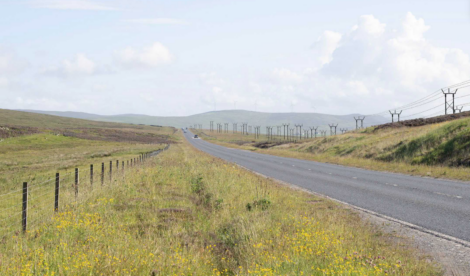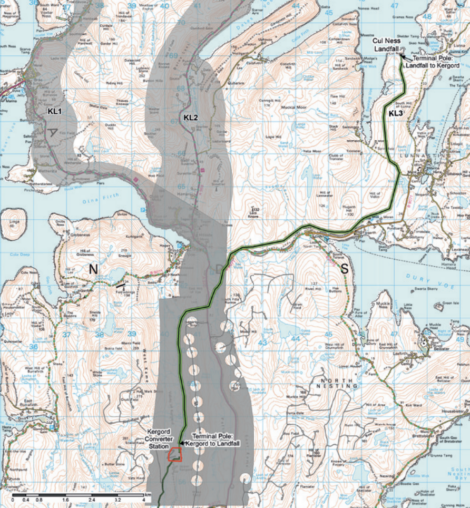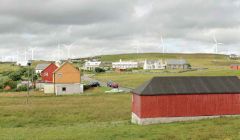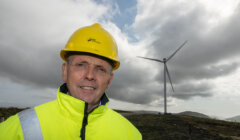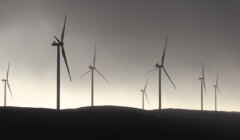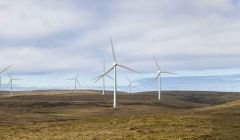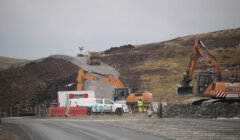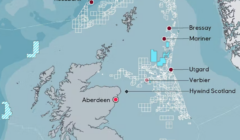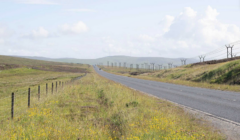Energy / No decisions yet on final routes of future overhead power line developments
MORE new overhead power lines are likely to be proposed for Shetland – but no decisions have yet been made as to exactly how they would be routed.
These lines are being planned to cater for Shetland’s new energy set-up once the isles are connected to the national grid via a subsea transmission link and are producing large amounts of renewable energy.
But more are set to be proposed on land between Kergord and the Lunnasting area, and also in Yell, in addition to some underground cable.
This is to allow the proposed 18-turbine Energy Isles and 17-turbine Beaw Field wind farms in Yell to export energy and link to the grid via the new Kergord substation.
A spokesperson for SSEN Transmission said: “At this time, no decisions have been made on routes or locations for the generator connections and the engineering design has not been determined.
“However it is likely a combination of overhead, underground and subsea infrastructure will be used depending on key specific geographical, environmental and technical considerations as development of the projects advance.”
Previous proposals mooted by SSEN Transmission show that the majority of power line between Kergord and the Lunnasting area could be overhead. Final engineering design and route alignment are still to be determined.
The overhead lines in the Central Mainland – larger than existing poles in Shetland and based on a trident design – would connect the proposed 12-turbine Mossy Hill wind farm, on the outskirts of Lerwick, to the network.
Become a member of Shetland News
They would also link to SSE’s new grid supply point currently being developed behind the Ocean Kinetics building in Lerwick, which will enable Shetland’s energy needs to be met through renewable generation.
But the visual impact of the new overhead lines has caused concern.
While some of the route between Lerwick and Kergord will see cable buried underground, the cost of putting all of the line in the soil is said to be prohibitive.
SSE is also proposing a new 132kV switching station in south Yell to connect the Energy Isles and Beaw Field wind farms.
There would also be a 12km subsea power cable between Yell and the Shetland mainland, with the possible landfall pinpointed as Cul Ness on the Lunna peninsula.
SSE recently held a consultation event in Yell around the proposed switching station on the island.
Consultation documents said the infrastructure will “also be available to connect future developments” in the south of Yell.
As with the Lerwick-Kergord project, applications for more overhead lines would have to go to the Scottish Government’s energy consents unit.
An application for overhead lines on part of the route between Kergord to the south Yell switching station is expected to be submitted in early 2024.
There is also expected to be an application for some overhead lines between the south Yell switching station and the proposed Energy Isles wind farm in the north west of the island.
The Energy Isles wind farm does not yet have consent but its developer hopes for a decision by the end of 2023.
Underground cables can be installed under permitted development rights.
A planning application to Shetland Islands Council will be required for the Yell switching station.
While the 103-turbine SSE Viking Energy wind farm in Shetland’s Central Mainland – the driver behind a subsea transmission link between the isles and the Scottish mainland – is due to be completed in 2024, the Yell and Mossy Hill wind farms are slated for 2027.
All three of those wind farm developments are now owned by Norwegian developer Statkraft.
It was also announced on Wednesday that the company is entering into negotiations with Shetland Islands Council for the potential lease of land at the former Scatsta Airport for future energy development.
Council to enter Scatsta land lease talks with energy companies
A spokesperson for SSE Transmission said the Shetland Renewable Connection projects – such as the Yell switching station and the overhead and underground lines through the spine of the Shetland mainland – will enable the connection of the Mossy Hill, Beaw Field and Energy Isles wind farms.
“To enable these Shetland renewable generations to connect to the grid, various transmission infrastructure connections are required,” they said.
“This includes creating a new switching station at Yell to enable the supply and generation of power from the Beaw Field and Energy Isles wind farms as well as the associated 132kV connection infrastructure, a 132kV connection link from the Yell Switching Station to Kergord, and a 132kV connection link from Mossy Hill wind farm into the Kergord to Gremista project – the latter of which is currently under construction.”
The spokesperson said the company will “consult extensively with the local community and key stakeholders to help inform the development of these projects, with the first stage of consultation for the main Yell to Kergord switching station underway, with further consultations planned for later in the year”.
There may be a requirement to provide additional connections to meet future generation or demand connections, for example new renewable connections or the decarbonisation of oil and gas platforms, and the enabling onshore infrastructure this may require.
Any new connection would be subject to consultation with all key stakeholders and the local community to help inform the development of the project, the company said.
Become a member of Shetland News
Shetland News is asking its many readers to consider paying for membership to get additional features and services: -
- Remove non-local ads;
- Bookmark posts to read later;
- Exclusive curated weekly newsletter;
- Hide membership messages;
- Comments open for discussion.
If you appreciate what we do and feel strongly about impartial local journalism, then please become a member of Shetland News by either making a single payment, or setting up a monthly, quarterly or yearly subscription.






